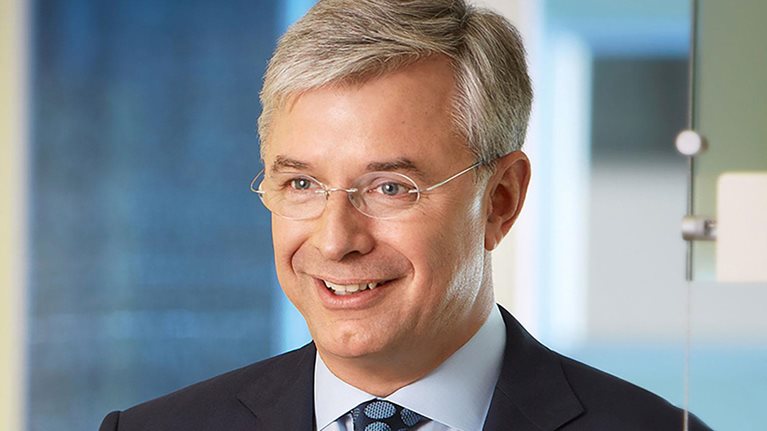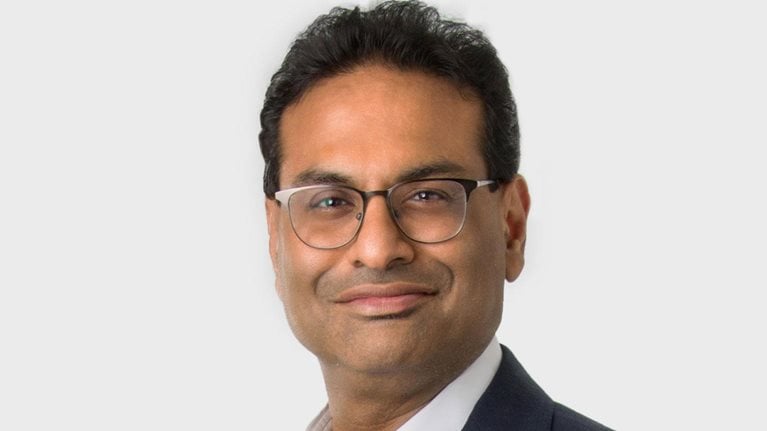As chairman and CEO of State Street Corporation, Ron O’Hanley oversees one of the largest and oldest American financial institutions, with $38 trillion in assets under custody and administration, and $3.5 trillion in assets under management. In this episode of the Inside the Strategy Room podcast, he tells Celia Huber, who leads McKinsey’s board services work in North America, why State Street’s focus on environmental, social, and corporate governance (ESG) issues has grown dramatically, what gaps in corporate America’s resilience the COVID-19 pandemic has revealed, and how State Street is disrupting its own business. This is an edited transcript of the discussion. You can subscribe to the series and listen to the full episode on your preferred podcast platform.
Celia Huber: Ron, how has the pandemic affected your industry and State Street specifically?
Ron O’Hanley: We do these tabletop exercises, “What are the key risks?” and a pandemic was one of them, but I don’t think anybody had any idea what it would mean for most businesses. For us, the impact was a bit counterintuitive because when the pandemic hit, economic activity shut down but our activity went up because as markets were reacting, raising transaction volumes and volatility, that’s when we get busy. So here we are in March, sending home about 90 percent of our people and being told by almost every country we operate in that we are being designated as essential. In many countries, it was impossible for us to keep people in the office given the epidemiological conditions. We have a big operation in China with 3,000 people, which we had to shut down in two days, so we got a flavor of the pandemic’s impact. I would like to say that this helped us get ready, but we did not anticipate the pandemic would move on like it did.
It was a good test of resilience and that is the biggest lesson coming out of this. The resilience I mean is the quite narrow operational resilience. It is the reason why we are a Global Systemically Important Financial Institution. Therefore, we have put a lot of money into technology and resilience, and the good news is it paid off. This point around resilience is something business and society need to be thinking through because it’s great that global policy makers and central banks are making these extraordinary moves, but at some point you have to ask: Wouldn’t we have been better off having invested in our public health infrastructure?
I would make the same resilience point regarding capital. The banking industry was forced to recapitalize after 2008 and that was appropriate given the size of these institutions, the scope of their activities, and those activities’ inherent and unknown risks. But most businesses are carrying far less capital now and you have to ask: Are we going to run the world anticipating that there will be the kind of government interventions we have seen to make up for the lack of investments in resilience? Boards have to look at it too. How do you think about a stock buyback, for example, versus investing it in shoring up the company’s resilience?
Celia Huber: In your broader role as an investor and a board director, what ESG implications has the pandemic highlighted?
Ron O’Hanley: We all have our moral views, but as an investor I think of it as part of the investment risk framework. As recently as five years ago you would hear, “Here is our asset allocation, and that’s all properly done, and let’s leave a little over here for speculation and a little over here to do good things.” That was ESG. I call that the “thou shalt not” stage—thou shalt not invest in sin stocks, for example. The second stage was “thou shall,” so thou shall invest in good things. Now, we have to look at portfolios and say, where is the ESG risk? How am I going to think about managing that risk either through diversification or by working with my holdings and, as a large institutional investor who can swing some weight, get them to take action?
The big index funds were early on this, which is a bit counterintuitive because they are supposed to be passive investors. But a passive investor has to own every company in the index. We have a large index business and I cannot get upset with a company and say, “From now on, it’s the S&P 499. We’re not going to own that stock.” Therefore, it’s the closest thing to permanent capital in the public markets. Index managers said, “We don’t have the tool of divestment so we have to be engaged with these portfolio companies.” And engagement meant starting to push on these ESG factors.
When was the peak market capitalization for coal? Everybody gets it wrong and usually by decades. It was in 2011. What did the investors who were buying in 2011 not know or should have known in relation to the E part of ESG?
Early on, it was around the G element: governance. Much of that was informed by the corporate scandals that happened 20 years ago: what is the oversight model and how does it work, board hygiene kinds of things. Now the attention has moved to the E element and much of that is practical. I always use the example of coal. When was the peak market capitalization for coal? Everybody always gets it wrong and usually by decades. It was in 2011. What did the investors that were buying in 2011 not know or should have known in relation to the E part of ESG?
Risk management is nothing more than the statement that more things can happen than will happen and incorporating those risks into the portfolio framework. Some are obvious. If you are a big real estate investor, you want to get a read on the risk of some properties being underwater or unattractive because they frequently flood or the shoreline has moved. Some considerations are more subtle. If I own a chemicals company and its feedstocks include petrochemicals, those may become far more costly or even may be legislated out of production.
Boards initially thought similarly to the investment community. “We ought to have a sustainability committee, which is our feel-good committee, and they will make sure we are doing the right things.” Increasingly, the conversation we have at State Street and on another board I sit on is, how do we make sure that all these ESG risks are incorporated into the charters and oversight of the various committees?
Subscribe to the Inside the Strategy Room podcast
Celia Huber: What is your advice for CEOs and management teams on how to convey those concerns to the board or investors?
Ron O’Hanley: Framing it in terms of risk is the best way to do it because CEOs and boards are used to thinking that way. If you frame it in any other way, it becomes a values argument. Values are important, but this is a value argument: What is this business worth if our beliefs about where the sea level will be or the cost and availability of certain fossil fuel change over the long term? By the way, we have only talked about G and E. The S is the latest frontier. I don’t think even three years ago it was inherently obvious why that element would be equally important to the other two, but it is. I heard a statistic that 50 percent of the elementary school children in the United States are non-white. If you are a retailer, this is a sign that your customer base is changing. Have we thought about who manages and oversees this company? Have we thought about product development?
The idea of stakeholder capitalism has become a lightning rod, but my view is simple: we are not going to maximize shareholder value if we disregard the rest of the stakeholders. At State Street, we are a talent-based business. If we do not attract and retain the best talent, our shareholders will suffer. Our investors are very worried about these E, S, and G issues, and if we do not pay attention to them, we will not have a customer base.
Celia Huber: I want to pull on the thread about the customer base and talent pool changing. State Street has made some bold stands, including the sponsorship of the Fearless Girl statue on Wall Street in 2017 that faces the bull. What motivated that?
Ron O’Hanley: The Fearless Girl had modest beginnings. We were formally incorporating women on boards into our stewardship guidelines, and not just the number of women but the organizations’ efforts to build board diversity. One of my colleagues had the idea of sponsoring the statue to coincide with International Women’s Day to underscore the importance of boards making this change happen. It was put on Wall Street not to challenge the bull but to illustrate that the way we would make inroads is not by having regulators tell us what to do but by boards incorporating that commitment into their oversight models.
The statue ended up getting a permanent spot and has been the most dressed up statue in New York, everything from a St. Patrick’s Day headdress to Ruth Bader Ginsburg’s neckwear. The addition of the shattered glass ceiling was quite intentional, too, to celebrate the progress on gender, most recently in the last election. Again, I come back to value versus values. One of my values is that diversity is good, but this is about the fact that more diverse boards and management teams lead to better long-term outcomes.
The idea of stakeholder capitalism has become a lightning rod, but my view is simple: we are not going to maximize shareholder value if we disregard the rest of the stakeholders.
Celia Huber: Tell us a bit about State Street’s strategy. What parts that you put in place before the pandemic are still relevant and how did you work with your top team to adapt your strategic priorities?
Ron O’Hanley: I had two years before the pandemic hit when I could focus deeply on our strategy. There are two parts to our business: asset management and investment services. The latter one is about 80 percent of what we do and it’s about the infrastructure of capital markets. It’s a great business but it was changing. Many areas that once drove growth were no longer there. The professionalization of investing throughout the world meant that there were not many mutual funds or fund ranges, for example, that had not already been formed.
Another change was that many investment organizations had grown from small boutiques into massive enterprises but their technology and operations reflected their boutique origins. State Street Global Advisors [the investment management arm] is an example. When I got here, it was a 50-year-old firm and it had three order-management systems and 19 risk systems. It wasn’t just a tech budget run amok; as we grew, we added on what we needed because few commercial options existed.
Now, the investment industry is facing the same challenge that virtually every other industry has around data. It is a combination of having the right data and managing that flood of data that we have. These technologies were not working with each other and were creating operational issues.
So, as part of our strategy in 2018 and 2019, we started pivoting to become an enterprise outsourcer to these firms in addition to our core infrastructure and back-office services. We identified what we didn’t have, built a lot out organically, and acquired Charles River Development to create a front-to-back enterprise outsource offering. When the pandemic came, we recognized a couple of challenges. One, 2020 was a very ambitious year for us in terms of technology and software delivery, and two, we had many conversations under way that we were uncertain we could continue. Anybody that is either an outsourcer or has outsourced something knows there is a big “solutioning” part to the sales cycle and we were not sure how we would do that remotely. Remarkably, it worked. We have a client now that we started talking to in April of last year and only one of us has ever met with this institution physically.
In March and April of 2020, there was unbelievable market upheaval and some pension funds and other clients were concerned about their liquidity. When markets are dropping, the last thing you want to do is sell your portfolio, but they needed liquidity, if only to pay their beneficiaries. So we tried to offer solutions that could finance that for them using their portfolios as collateral. By May, we started to focus back on the strategic pivot.
In many respects, we are fortunate because if somebody had to be convinced that they needed to upgrade their technology and operations, the events of last year showed them why. It is not just troubled institutions; some of the most successful fund managers in the world have come to us. Their view is, “We could afford to do this ourselves, maybe equally well as you, but we would rather put our incremental resources into developing better sources of investment return.”
Celia Huber: Could you share how your perspective on leadership has evolved, both before and during the pandemic?
Ron O’Hanley: You become more mindful in a crisis like this. In 2008, the financial services industry faced existential concerns. In the pandemic, we thought much more about the health of our employees than we ever had before. There is a lot lacking in remote working. First of all, innovation takes longer. Those conference rooms with white boards and papers everywhere, certainly the strategy we are operating on came out of rooms like that. There is also the apprenticeship element. I am very concerned that we have hired 2,000 people since the pandemic and most of them have never met anybody in person. I think about the importance of observing and listening and learning from others during my own career, so we very much will be back in the office, but we will be more mindful about why we are there. Remote work has been a grand experiment, but you start to worry about people’s mental health. We don’t talk much about mental health, certainly in employment situations, but even those people in comfortable homes may not be doing fine at all.
As well, in a crisis like this, we need to talk about the why. We’ve got the what down—we know what needs to be done—and oftentimes we know how to do it, but we don’t spend enough time in the why. Why, for example, do we think it’s so important to take a stand on voting rights? Long-time employees may ask, “Why do we want to attract attention to ourselves with this very public stand?” It is a good question that deserves an answer. Is it even the role of corporate CEOs to do that? I go back to the idea that you will not satisfy the shareholders if you don’t satisfy the rest of the stakeholders. It becomes difficult for firms to ignore these issues when people know that they have power and influence. But if you are going to use your power, you need to make sure that you can make a difference and are willing to follow through. The real danger is that most firms underestimate the difference they can make.


